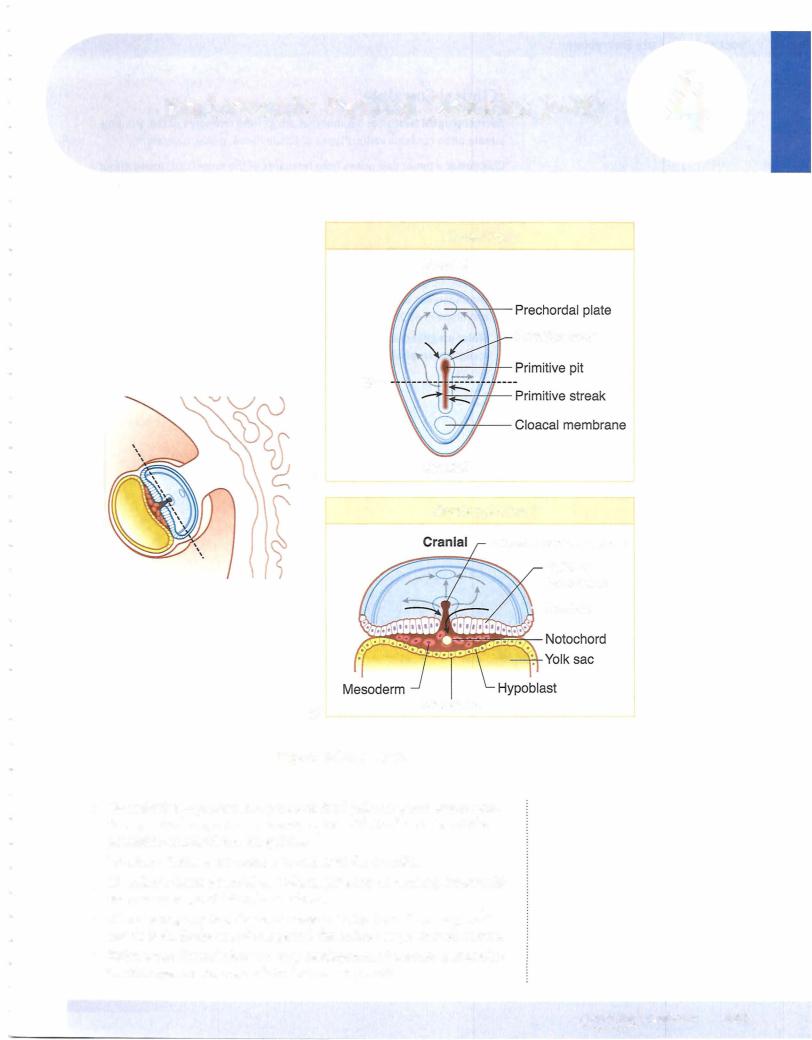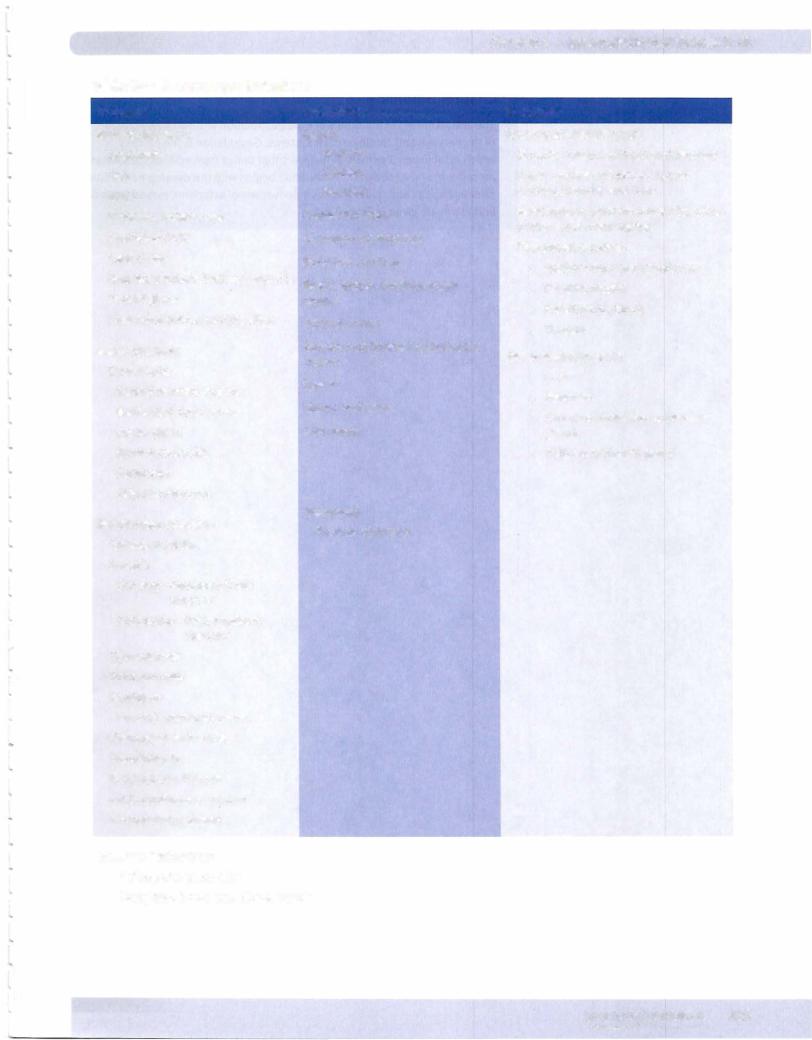
- •Contents
- •1. Cell Biology and Epithelia
- •2. Connective Tissue
- •3. Cartilage and bone
- •5. Nervous Tissue
- •6. Immune Tissues
- •7. Respiratory System
- •8. Gastrointestinal System
- •12. Integument
- •1. Gonad Development
- •4. Embryonic Period (Weeks 3-8)
- •1. Back and Autonomic Nervous System
- •2. Thorax
- •5. Lower Limb
- •4. The Spinal Cord
- •5. The Brain Stem
- •7. Basal Ganglia
- •11. Limbic System
- •Index

Embryonic Period (Weeks 3-8) |
4 |
Dorsal View
Cranial
Primitive node
8---
Caudal
A
Sectional View
Primitive node & streak
Epiblast (ectoderm)
-Amnion
BEndoderm
Figure 11-4-1 . Week 3
•Gastrulation--rocessp that produces the 3 primary germ layers: ecto derm, mesoderm, and endoderm; begins with the formation of the primitive streakwithin the epiblast
•Ectoderm forms neuroectoderm and neural crest cells.
•Mesoderm forms paraxialmesoderm (35 pairs of somites), intermedi ate mesoderm, and lateral mesoderm.
•Allmajor organ systems begin to develop during the embryonic period
(weeks 3-8).By the end of this period, the embryo begins to look human.
•Thirdweek: Gastrulation and early development of nervous and cardio vascular systems; corresponds to first missed period.
MEDICAL 165

Section II • Early Embryology
Clinical Correlate
Sacrococcygealteratoma: a tumor that arises from remnants ofthe primitive streak; often contains various types oftissue (bone, nerve, hair, etc)
Chordoma: a tumor that arises from remnants of the notochord, found either intracranially or in the sacral region
Hydatidiform mole: results from the partial or complete replacement ofthe trophoblast by dilated villi
•In a complete mole, there is no embryo; a haploid sperm fertilizes a blighted ovum and reduplicates so that the karyotype is 46,XX, with all chromosomes of paternal origin. In a partial mole, there is a haploid set of maternal chromosomes and usually 2 sets of paternal chromosomes so that the typical karyotype is 69,XXY.
•Molar pregnancies have high levels of hCG, and 20% develop into a malignant trophoblastic disease, including choriocarcinoma.
1 66 MEDICAL

Chapter 4 • Embryonic Period (Weeks 3-8)
Table 11-4-1. Germ Layer Derivatives
Ectoderm |
Mesoderm |
|
Surface ectoderm |
Muscle |
|
Epidermis |
Smooth |
|
Hair |
Cardiac |
|
Nails |
Skeletal |
|
|
||
Inner ear, external ear |
Connective tissue |
|
Enamel ofteeth |
All serous membranes |
|
Lens ofeye |
Bone and cartilage |
|
|
||
Anterior pituitary (Rathke's pouch) |
Blood, lymph, cardiovascular |
|
Parotid gland |
organs |
|
Anal canal below pectinate line |
Adrenal cortex |
|
|
||
Neuroectoderm |
Gonads and internal reproductive |
|
organs |
||
Neural tube |
||
|
||
Central nervous system |
Spleen |
|
|
||
Retina and optic nerve |
Kidney and ureter |
|
|
||
Pineal gland |
Dura mater |
|
Neurohypophysis |
|
|
Astrocytes |
|
|
Oligodendrocytes |
|
|
Neural crest ectoderm |
Notochord |
|
Nucleus pulposus |
||
Adrenal medulla |
||
|
||
Ganglia |
|
|
Sensory-Pseudounipolar |
|
|
Neurons |
|
|
Autonomic-Postganglionic |
|
|
Neurons |
|
|
Pigment cells |
|
|
Schwann cells |
|
|
Meninges |
|
|
Pia and arachnoid mater |
|
|
Pharyngeal arch cartilage |
|
|
Odontoblasts |
|
|
Parafollicular (C) cells |
|
|
Aorticopulmonary septum |
|
|
Endocardial cushions |
|
|
Yolk sac derivatives: |
|
|
Primordial germ cells |
|
Early blood cells and blood vessels
Endoderm
Forms epithelial lining of:
GI track: foregut, midgut, and hindgut
Lower respiratory system: larynx, trachea, bronchi, and lung
Genitourinary system: urinary bladder, urethra, and lower vagina
Pharyngeal pouches:
•Auditory tube and middle ear
•Palatine tonsils
•Parathyroid glands
•Thymus
Forms parenchyma of:
•Liver
•Pancreas
•Submandibular and sublingual glands
•Follicles ofthyroid gland
M EDICAL 167

Section II • Early Embryology
ChapterSummary
•The critical events ofthe third week are gastrulation and early development ofthe nervous and cardiovascular systems. Gastrulation is the process which establishes 3 primary germ layers that derive from epiblast: ectoderm, mesoderm, and endoderm. Gastrulation begins with the development of the primitive streak and node. The adult derivatives of ectoderm, mesoderm, and endoderm are given in Table 11-4-1.
168 MEDICAL

SECTION
GrossAnatomy

